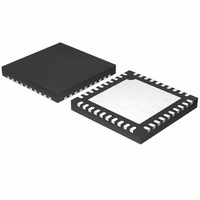SI3452D-B01-GM Silicon Laboratories Inc, SI3452D-B01-GM Datasheet - Page 25

SI3452D-B01-GM
Manufacturer Part Number
SI3452D-B01-GM
Description
IC POE CONTROLLER MIDSPAN 40QFN
Manufacturer
Silicon Laboratories Inc
Datasheet
1.SI3452B-B01-GM.pdf
(36 pages)
Specifications of SI3452D-B01-GM
Package / Case
40-QFN
Controller Type
Power over Ethernet Controller (POE)
Interface
I²C
Voltage - Supply
3 V ~ 3.6 V
Current - Supply
14mA
Operating Temperature
-40°C ~ 85°C
Mounting Type
Surface Mount
Maximum Power Dissipation
1.2 W
Minimum Operating Temperature
- 40 C
Mounting Style
SMD/SMT
Product
Ethernet Controllers
Standard Supported
IEEE 802.3at, IEEE 802.3af
Supply Voltage (max)
3.6 V
Supply Voltage (min)
3 V
Supply Current (max)
14 mA
Maximum Operating Temperature
+ 85 C
Lead Free Status / RoHS Status
Lead free / RoHS Compliant
Lead Free Status / RoHS Status
Lead free / RoHS Compliant, Lead free / RoHS Compliant
Other names
336-1835-5
Available stocks
Company
Part Number
Manufacturer
Quantity
Price
Company:
Part Number:
SI3452D-B01-GM
Manufacturer:
Silicon Labs
Quantity:
135
Si3452
6. Operational Notes
6.1. Port Turn On
If the port is turned on by putting it in auto mode, the Si3452 will take care of all specified timing, and it will take
care of the two-event classification if the first event result is Class 4 and PoE+ mode is enabled. However, if
automatic mode operation is not desired after port turn-on, the port should be set to semi-auto or manual mode
once it has powered. In automatic mode, I
is set according to the classification result.
CUT
The port turn-on command is used to turn on a port in semi-auto or manual mode. If the port is turned on in semi-
auto mode, turn-on is delayed until the next detection and classification. If the detection or classification result is
not valid, the port will not power. If the classification is Class 4 and PoE+ mode is enabled, a 2-event classification
is given. I
setting is not automatic for port turn-on in semi-auto or manual mode.
CUT
If the port is turned on by putting it in manual mode, the normal sequence is to start with the port in semi-auto mode
and interrupt on a classification complete, which indicates that there is a valid PD signature and that a classification
result is available. Based on the classification result, the host can make a decision to apply power or not. The IEEE
standard requires that a port be powered within 400 ms of a valid detect complete. It is also desirable to power the
port prior to the start of the next detection pulse, which can occur in as little as 300 ms. Therefore, it is
recommended that ports be powered in under 250 ms from the class complete interrupt when using the manual
mode turn-on command.
Using manual mode turn-on, detection is not done prior to port turn on, but classification is always performed just
prior to port turn on. Ports are turned on in manual mode regardless of the classification result. 2-event
classification is performed if the first event result is Class 4 and the port is enabled for PoE+ mode. The manual
mode classification step does not generate a classification complete flag because it is assumed that the
classification was already done in semi-auto mode and the host has already made the decision to grant power.
During the initial 60 ms (Tstart) time of port turn-on, 1x current limit and I
= 375 mA (nominal) is enforced. After
CUT
2
Tstart, if the port is not overloaded, Pgood is set to true, and I
and 1x or 2x current limit will follow the I
C
CUT
2
register settings. In auto mode, the I
C registers are set according to the classification result, but, if desired, they
can be overwritten after Pgood becomes true. After Tstart, 2x current limit is always allowed if PoE+ mode is
enabled.
6.2. Changing the Interrupt Mask
The INT register and INT pin are always synchronized. However, there can be up to a 5 ms delay between an
event that causes or clears an interrupt and the update of the register and pin.
Thus, if the INT mask register is changed to clear an interrupt or to block an interrupt source, there can be up to a
5 ms delay between the change of the INT mask register and the resultant change in the INT register and INT pin.
Generally, use of the mask register to clear interrupts is not recommended; it is better to clear an interrupt by
reading the appropriate COR register.
6.3. Port Voltage and Current Measurements
Port current voltage and current are reported as of the time the measurement command is written to register 0x12.
Spikes of current or other momentary current changes are not filtered. It may be desirable to add a ~1 second
averaging filter to reported current when using port current information for power management decisions.
Rev. 1.2
25














